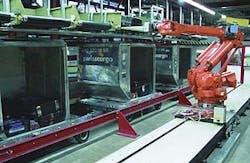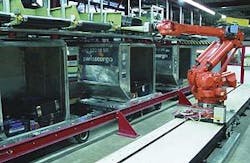Robotic baggage-handling system does the lifting
At airports, most of the aircraft baggage-loading operations are still performed by workers hand-loading bags onto conveyor belts, into containers, and then on-board the aircraft—a time-consuming, expensive, and laborious process. To automate this procedure, ABB (Zurich, Switzerland; www.abb.com) has built an automated baggage-loading system (ABLS) and formed a new company, Onero (Mannheim, Germany; www.onero.com), to deploy the system at Switzerland's Zurich airport.
"Although the automated system uses robots to sort and load bags," says Gunar Baier, Onero managing director, "bag-analysis and loading sequences must be planned before the bag is handled." To accomplish this, the automated system collects information on each bag's weight, size, shape, and destination. In the first step, a laser barcode scanner reads the tags on the bags and compares the captured data to known flight data. Bags are then weighed on a conveyor belt moving at 2 m/s. Next, bag geometry is scanned using a pair of LMS 200 laser scanners from Sick (Minneapolis, MN; www.sick.com) that provide resolutions of ±20 mm at up to 8 m. These scanners are linked to the system's computers over 500-Kbit/s, RS-485 interfaces.
After the various bag parameters have been established, the order in which the bags are loaded into the aircraft is determined. Data from the airport flight-information system also reveal if the passenger has already checked in and if the bag can be loaded. Software modules track the current baggage space available on the aircraft.
The system also generates a loading list, which contains the accurate weight of each bag and details of each bag's location. Two configurations are used to implement automatic bag loading. Either the baggage-loading robot can remain in one position or the robot can travel along a track. Size, layout, and intensity of passenger traffic in the airport help determine which configuration is selected for a particular aircraft. Other software tools direct the robot to pick and transfer the bags from the conveyor belt.
To perform bag-analysis calculations, load management, and feedback control, PCs linked via TCP/IP Ethernet and running Windows NT are used. According to Baier, Windows NT software and the TCP/IP network reduce the interval between bag analysis and loading to 0.5 s. All the conveyor belts in the system are governed by a programmable logic controller (PLC) networked with Profibus. While the use of an industrial embedded PC was possible, the engineers opted for the simpler PLC design. Most existing conveyer systems in airports are already automated with PLCs.
According to Günther Nagel, Onero head of projects, the major portion of the software for the ABLS was developed in C++. Using ABB IR6400 robots capable of handling payloads of around 150 kg, the robots and conveyor belts are all controlled with ABB PLCs and software. Depending on robot cell design, the capacity of the automated loading system can be from 120 to 300 bags per hour, and the robot performs uninterrupted. The loading system enables a supervisor to oversee as many as four stations.

